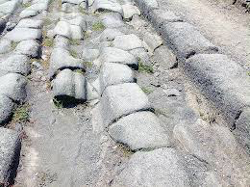|
Romans Plugged Pompeii Potholes with Molten Iron: Archaeologists
May 17, 2019
The Romans living in Pompeii used molten iron to repair their stone streets, archaeologists have found. The team found traces of the iron in various places in or near the Italian city's paving stones. The iron would have been heated to a very high temperature and then poured into the holes, filling the space as it cooled, the archaeologists said. Such a repair strategy would have been faster and less expensive than a full-blown repaving exercise. What the archaeological team doesn't yet know is how the Romans poured the molten iron. They have not found remains of any equipment that would have been used. As well, no other instance of such of a use for molten iron has yet been uncovered in areas occupied by the Romans. Archaeologists also found smaller deposits of iron on streets that didn't need repair and suggested that such areas were examples of spills from whatever mechanism was used to transport the molten iron around the city. Also found in the holes between stones were pieces of terracotta and ceramics. The city, along with nearby Herculaneum, was covered by a mountain of volcanic ash in the space of a day in A.D. 79. The two cities have consistently yielded iconic archaeological finds in recent years. |
|
Social Studies for Kids
copyright 2002–2024
David White






